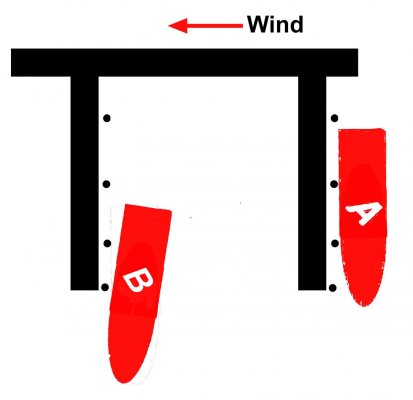Have a question for you captains about getting off a face dock with the wind blowing the boat against the dock.
If the boat is bow in, it's simple... tie off the bow to a midship dock cleat, rudder toward dock, and forward throttle will swing the stern out so one can easily back out. But, that's not the issue.
The boat is stern in, side tie to starboard. Typically I can shove it off (at least the bow) and put the starboard engine in idle forward, and the port in idle reverse and it will twist the boat just enough to head straight out.
However, the other day, the winds were a bit strong and the above didn't work. No way to push the boat off a bit. Doing the above just didn't get the boat out far enough to get out. So, I'd do that and inch forward a few feet when the boat came back to the dock. Repeat again, for a few more feet.
When the boat was about half way out, it became hard to keep the bow from swinging past the dock, which would have been really awkward, so I turned the wheel toward the dock, using forward on the port and reverse on the starboard, kept the boat barely off the dock and pushed it out in the fairway, but as it turned 90d. But at that point it was easy to just motor away without being blown back into the dock.
Looking for more graceful ways of handling this.
I was single handling.
If the boat is bow in, it's simple... tie off the bow to a midship dock cleat, rudder toward dock, and forward throttle will swing the stern out so one can easily back out. But, that's not the issue.
The boat is stern in, side tie to starboard. Typically I can shove it off (at least the bow) and put the starboard engine in idle forward, and the port in idle reverse and it will twist the boat just enough to head straight out.
However, the other day, the winds were a bit strong and the above didn't work. No way to push the boat off a bit. Doing the above just didn't get the boat out far enough to get out. So, I'd do that and inch forward a few feet when the boat came back to the dock. Repeat again, for a few more feet.
When the boat was about half way out, it became hard to keep the bow from swinging past the dock, which would have been really awkward, so I turned the wheel toward the dock, using forward on the port and reverse on the starboard, kept the boat barely off the dock and pushed it out in the fairway, but as it turned 90d. But at that point it was easy to just motor away without being blown back into the dock.
Looking for more graceful ways of handling this.
I was single handling.

